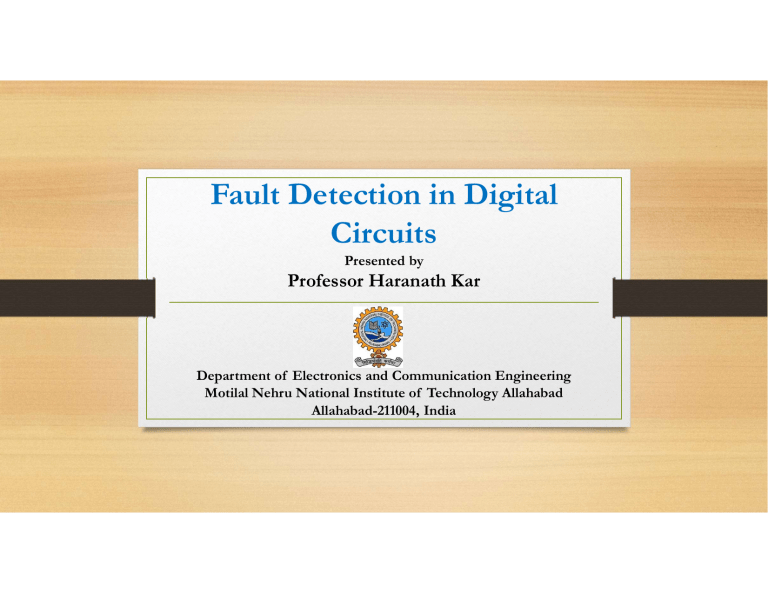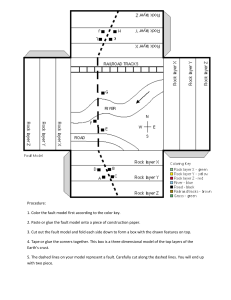
Fault Detection in Digital
Circuits
Presented by
Professor Haranath Kar
Department of Electronics and Communication Engineering
Motilal Nehru National Institute of Technology Allahabad
Allahabad-211004, India
Types of faults
• Digital circuits may suffer two classes of faults:
a) Temporary faults:
(Occur due to noise and the nonideal transient behaviour of switching
components)
b) Permanent faults:
(Occur due to component failures)
2
Transient Phenomenon
• Consider the function
𝑧 𝑥𝑦 00
0
1
01
11
10
1→0
1
1
1→0
1
1
∗1→0→1
0→1
0→1
(* if
𝒑𝒅𝟐
𝒑𝒅𝟏
3
Glitch and Hazard
• The output of a combinational circuit may make a transition even
though the patterns applied at its inputs do not imply a change. These
unwanted switching transients are called “glitches”.
• A circuit in which a “glitch” may occur under appropriate inputs is
said to have a “hazard”.
4
Static Hazards
• Static-1 Hazard
𝟏
𝟏
Output pattern: 𝟏 → 𝟎 → 𝟏
(may occur in two-level AND-OR realization)
𝟎
• Static-0 Hazard
𝟏
Output pattern: 𝟎 → 𝟏 → 𝟎
(may occur in two-level OR-AND realization)
𝟎
𝟎
5
Static Hazards (continued…)
• A static hazard is a situation in which a single input-variable change
might cause a momentary incorrect output, when in fact the output
should remain constant.
• A minimal realization of a digital circuit might not be hazard-free.
6
Elimination of Static Hazards
• Consider the function 𝒇 𝒙, 𝒚, 𝒛 = ∑(𝟐, 𝟑, 𝟓, 𝟕)
𝑧 𝑥𝑦 00
0
1
01
11
10
1
𝑥̅
𝑦
𝑥
𝑧
1
1
𝑓 𝑥, 𝑦, 𝑧 = 𝑥̅ 𝑦 + 𝑥𝑧 + 𝑦𝑧
1
𝑦
𝑧
• Static hazard can be removed by including the prime implicant 𝒚𝒛 in the expression
for ‘𝒇’.
7
Dynamic Hazards
• Dynamic hazards are a consequence of multiple static hazards in a multilevel circuit.
1
1
0
1
0
0
1
0
The necessity of eliminating hazards confronts the designer with two conflicting
considerations.
1. Simplicity of the circuit: Minimal functions are most vulnerable to hazards.
2. Reliability of the circuit: To avoid hazards, it is necessary to add some redundant gates.
8
Why do we require testing?
Various types of errors can occur during the manufacturing process.
• Errors during the design phase
• Bugs during synthesis (in the CAD tools used)
• Faults during fabrication
There are billions of transistors in today's chips.
• Possibility of faults creeping in is also significant.
Testing is used to detect the presence of faults in a given circuit.
• No amount of testing can ensure that the circuit is free of faults
• By testing, we can boost our confidence in the correct working of the circuit.
9
When to do testing?
Testing can be done at various levels.
• Chip level: when chips are manufactured
• Board level: when chips are assembled on the boards
• System level: when several boards are assembled together
Rule of thumb:
• Early detection of a fault reduces the cost of testing.
• It is 10 times more expensive to test a digital system as we move to the next
higher level (Chip → Board → System).
10
Problem in Fault Detection
• The number of possible physical defects in the circuit may be excessive.
• Solution: Study the physical defects and construct some fault models. A fault
model identifies the targets for testing. A fault model makes the analysis
possible.
How many faults are getting tested?
• Fault coverage = (Number of detected faults/Total number of faults)
100 %
11
Fault Models
To reduce the complexity of test generation, one needs to
model the actual defects that may occur in a chip with fault
models.
12
Structural Fault Models
• Structural fault models
In structural testing, we need to ensure that the interconnections in the given
structure are fault-free and are able to carry both 0 and 1 signals.
• Stuck-at 0 (s-a-0) fault
• Stuck-at 1 (s-a-1) fault
A stuck-at fault does not always indicate that the line is shorted to ground or a
power line. It could serve as a model for a variety of other cuts and shorts, both
internal and external to a gate.
13
Switch-level Fault Models
• Switch-level fault models
• Switch-level fault modeling is concerned with faults in transistors and
interconnects in a switch-level description of a circuit.
• This fault model has primarily been used with MOS technologies, specifically
CMOS technology.
• Stuck-open fault: A transistor has become permanently nonconducting due to some
defect.
• Stuck-on fault: A transistor has become permanently conducting due to some defect.
14
Bridging Fault Models
Two or more normally distinct lines are shorted together.
Input bridging: Can form wired-logic.
Feedback (Input-to-output) bridging: Can cause oscillations or
latching (additional memory)
15
Fault detection methods for combination
circuits
Fault table method
Path-sensitizing method
Boolean difference method
16
Derivation of minimal set of faultdetection tests
𝑚
𝐴
𝑛
𝐵
1
𝑝
2
𝐶′
𝑞
𝑓 = 𝐴𝐵 + 𝐶′
Circuit to be tested
Inputs
𝐴𝐵𝐶
𝒇
Outputs in presence of faults
000
1
1
1
1
0
1
1
1
1
001
0
0
0
0
0
0
0
1
1
010
1
1
1
1
0
1
1
1
1
011
0
0
0
0
0
1
0
1
1
100
1
1
1
1
0
1
1
1
1
101
0
0
0
0
0
0
1
1
1
110
1
1
1
1
1
1
1
1
1
111
1
0
0
0
1
1
1
1
1
𝑓
𝑓
𝑓
𝑓
𝑓
𝑓
Truth Table
𝑓
𝑓
17
Fault Table
Inputs
𝐴𝐵𝐶
Possible faults
𝑚 ,𝑛 ,𝑝
000
𝑞
𝑚
𝑛
𝑝 ,𝑞
1
001
1
010
1
011
1
100
1
1
101
1
1
110
111
Essential Tests: {3, 5, 7}
1
Minimal Complete Test Set: {3, 5, 7, 0 or 2 or 4}
18
Path sensitizing method
𝑥
𝑦
𝑎
2
𝑐
Input
Other input variables required to
sensitize the path
Test nos.
Faults
detected
𝑎𝑑𝑒
𝑥=0
𝑦 = 1, 𝑧 = 0
2
𝑎 ,𝑑 , 𝑒
𝑥=1
𝑦 = 1, 𝑧 = 0
6
𝑎 ,𝑑 , 𝑒
𝑦=0
𝑥 = 1, 𝑧 = 0
4
𝑏 ,𝑑 , 𝑒
𝑦=1
𝑥 = 1, 𝑧 = 0
6
𝑏 ,𝑑 , 𝑒
𝑧=0
𝑥=𝑦=0
or, 𝑥 = 0, 𝑦 = 1
or, 𝑥 = 1, 𝑦 = 0
0 or 2 or 4
𝑐 ,𝑒
𝑧=1
𝑥=𝑦=0
or, 𝑥 = 0, 𝑦 = 1
or, 𝑥 = 1, 𝑦 = 0
1 or 3 or 5
𝑐 ,𝑒
1
𝑏
𝑑
𝑧
Path
Circuit
𝑒
𝑏𝑑𝑒
𝑓
𝑐𝑒
Essential Tests: {2, 4, 6}
Minimal Complete Test Set: {2, 4, 6, 1 or 3 or 5}
19
Boolean Difference
• If 𝒇(𝒙) = 𝒇 𝒙𝟏 , … , 𝒙𝒊 , … , 𝒙𝒏 , then
𝒅 𝒇(𝒙)
𝒅𝒙𝒊
= 𝒇 𝒙𝟏 , … , 𝒙𝒊 , … , 𝒙𝒏 ⊕ 𝒇 𝒙𝟏 , … , 𝒙𝒊 , … , 𝒙𝒏
= 𝒇 𝒙𝟏 , … , 𝒙𝒊
𝟏 , 𝟎, 𝒙𝒊 𝟏 , … , 𝒙𝒏
⊕ 𝒇 𝒙𝟏 , … , 𝒙𝒊
𝟏 , 𝟏, 𝒙𝒊 𝟏 , … , 𝒙𝒏
• If 𝒇(𝒙) = 𝒙𝟏 𝒙𝟐 + 𝒙𝟑, then
𝒅 𝒇(𝒙)
𝒅𝒙𝟏
•
•
= 𝟎 . 𝒙𝟐 + 𝒙 𝟑 ⊕ 𝟏 . 𝒙𝟐 + 𝒙 𝟑 = 𝒙 𝟑 ⊕ 𝒙 𝟐 + 𝒙 𝟑 = 𝒙 𝟐 𝒙 𝟑
𝒅 𝒇(𝒙)
𝒅𝒇(𝒙)
𝒅𝒙𝒊
𝒅 𝒇(𝒙)
𝒅𝒙𝒊
𝒅𝒙𝒊
𝒅 𝒇(𝒙)
𝒅𝒙𝒊
20
Fault Detection using Boolean Difference
• Set of tests which detect s-a-0 fault
𝒅 𝒇(𝒙)
𝒊 𝒅𝒙
𝒊
• Set of tests which detect s-a-1 fault
𝒊
𝒅 𝒇(𝒙)
𝒅𝒙𝒊
21
Example
22
Example (continued…)
• To detect s-a-0 fault at line ‘ ’ :
𝒙𝟏
𝒅𝒇
𝒅𝒙𝟏
=𝟏
⇒ 𝒙𝟏 𝒙𝟐 𝒙𝟑 =1
Test no. : 6
• To detect s-a-1 fault at line ‘ ’ :
𝒅𝒇
𝒙𝟏 𝒅𝒙 = 𝟏
𝟏
⇒ 𝒙𝟏 𝒙𝟐 𝒙𝟑 =1
Test no. : 2
23
Example (continued…)
• To detect s-a-0 fault at line ‘ ’ :
𝒅𝒇
𝒈 𝒅𝒈 = 𝟏
⇒ ( 𝒙𝟏 𝒙𝟐 ) . 𝒙𝟑 =1
Test no. : 6
• To detect s-a-1 fault at line ‘ ’ :
𝒅𝒇
𝒈𝒅𝒈 = 𝟏
⇒ (𝒙𝟏 + 𝒙𝟐 ) 𝒙𝟑 = 𝟏
Test no. : 0 or 2 or 4
24
Thank You


